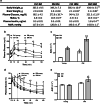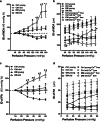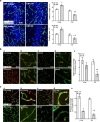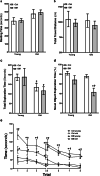Aging exacerbates impairments of cerebral blood flow autoregulation and cognition in diabetic rats
- PMID: 32696219
- PMCID: PMC7525432
- DOI: 10.1007/s11357-020-00233-w
Aging exacerbates impairments of cerebral blood flow autoregulation and cognition in diabetic rats
Abstract
Diabetes mellitus (DM) is a leading risk factor for aging-related dementia; however, the underlying mechanisms are not well understood. The present study, utilizing a non-obese T2DN diabetic model, demonstrates that the myogenic response of the middle cerebral artery (MCA) and parenchymal arteriole (PA) and autoregulation of cerebral blood flow (CBF) in the surface and deep cortex were impaired at both young and old ages. The impaired CBF autoregulation was more severe in old than young DM rats, and in the deep than the surface cortex. The myogenic tone of the MCA was enhanced at perfusion pressure in the range of 40-100 mmHg in young DM rats but was reduced at 140-180 mmHg in old DM rats. No change of the myogenic tone of the PA was observed in young DM rats, whereas it was significantly reduced at 30-60 mmHg in old DM rats. Old DM rats had enhanced blood-brain barrier (BBB) leakage and neurodegeneration, reduced vascular density, tight junction, and pericyte coverage on cerebral capillaries in the CA3 region in the hippocampus. Additionally, DM rats displayed impaired functional hyperemia and spatial learning and short- and long-term memory at both young and old ages. Old DM rats had impaired non-spatial short-term memory. These results revealed that impaired CBF autoregulation and enhanced BBB leakage plays an essential role in the pathogenesis of age- and diabetes-related dementia. These findings will lay the foundations for the discovery of anti-diabetic therapies targeting restoring CBF autoregulation to prevent the onset and progression of dementia in elderly DM.
Keywords: Autoregulation; Blood-brain barrier; Cognitive impairments; Diabetes mellitus; Myogenic response.
Conflict of interest statement
The authors declare that they have no conflict of interest.
Figures









References
-
- Abd-Elrahman KS, Colinas O, Walsh EJ, Zhu HL, Campbell CM, Walsh MP, Cole WC. Abnormal myosin phosphatase targeting subunit 1 phosphorylation and actin polymerization contribute to impaired myogenic regulation of cerebral arterial diameter in the type 2 diabetic Goto-Kakizaki rat. J Cereb Blood Flow Metab. 2017;37:227–240. doi: 10.1177/0271678X15622463. - DOI - PMC - PubMed
Publication types
MeSH terms
Grants and funding
LinkOut - more resources
Full Text Sources
Miscellaneous

